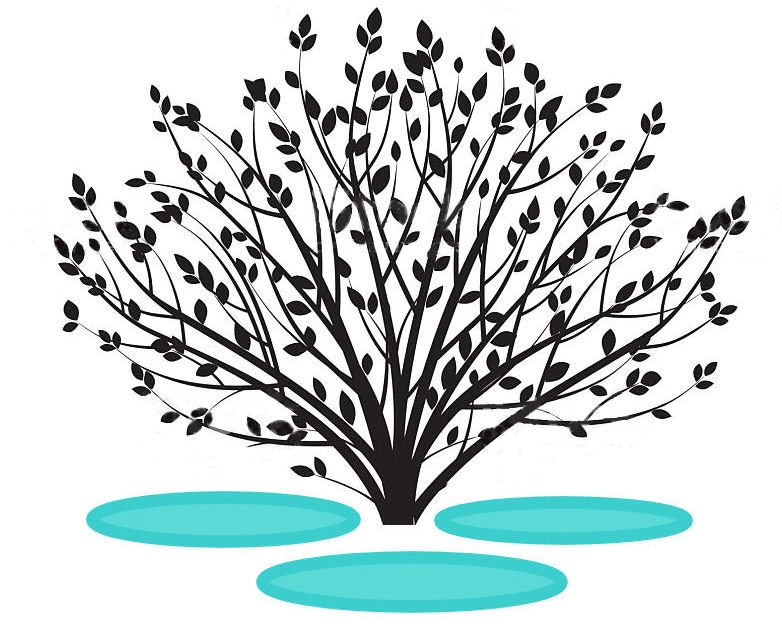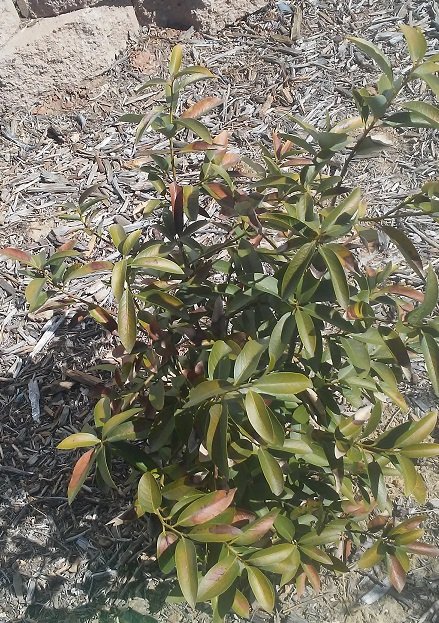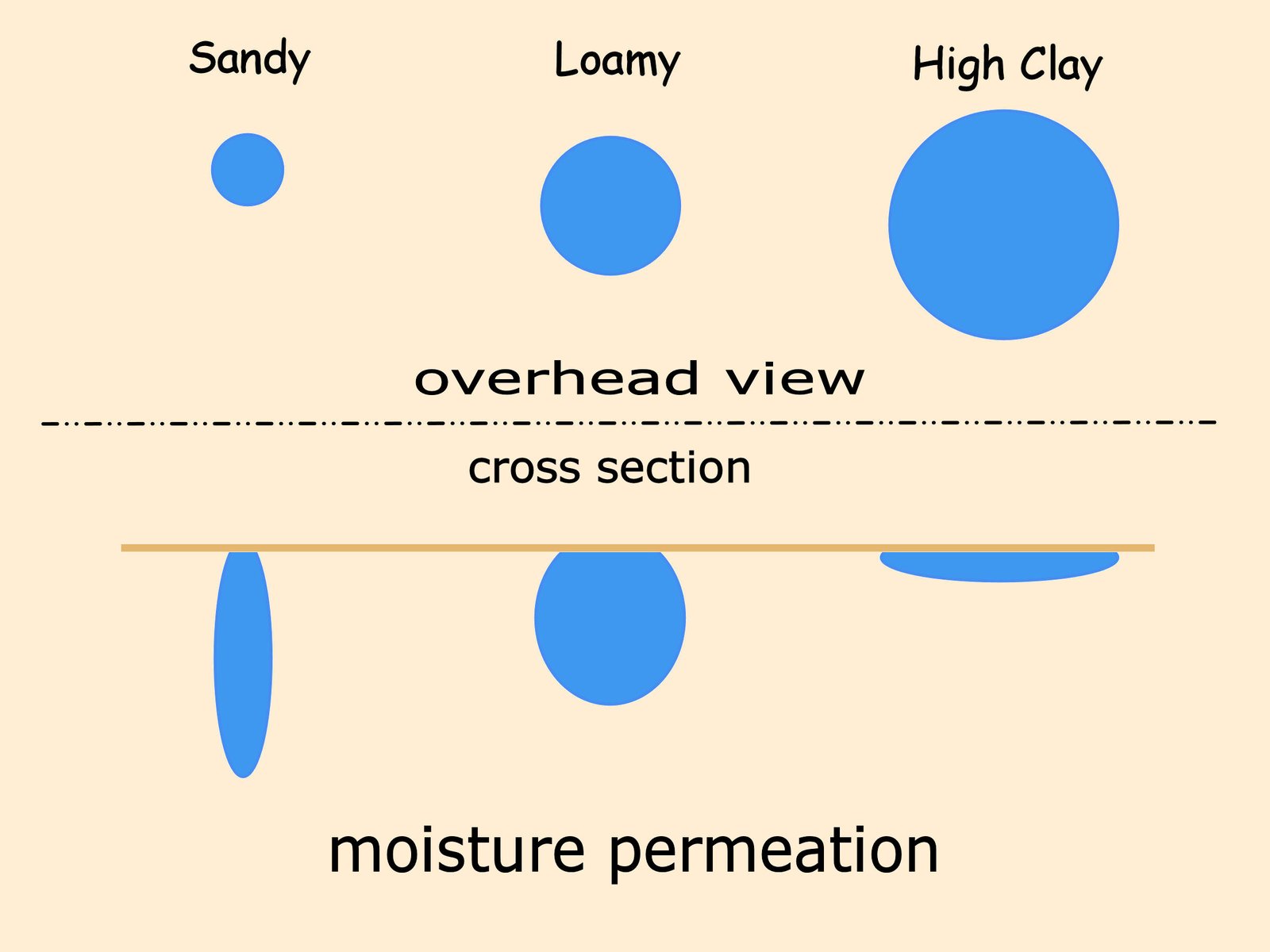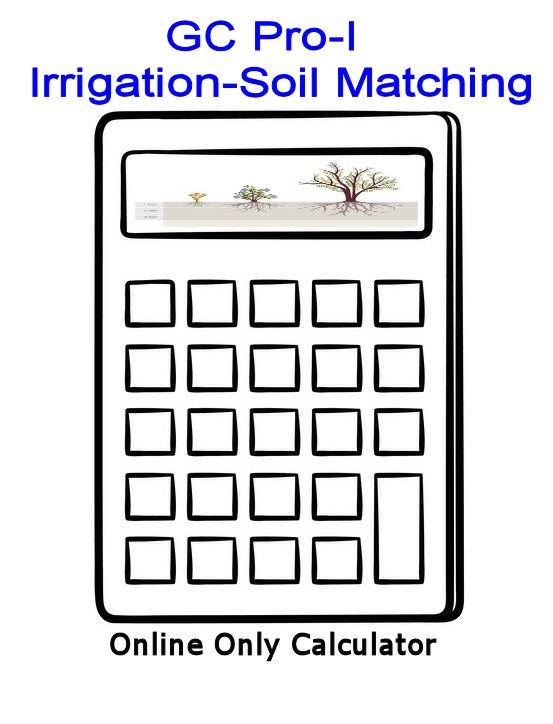
Drip Irrigation Basics
Proper Drip Spacing & Placement
Moisture Distribution
Proper Drip Spacing & Placement
Moisture Distribution
Garden Tip
TB1113
TB1113
Technical Bulletin Series

|
Drip Irrigation Basics Proper Drip Spacing & Placement Moisture Distribution |
Garden Tip TB1113 |
Technical Bulletin Series
|
Though Drip Irrigation has many times been demonstrated to be
the most efficient use of water for plants, too often it is not
properly installed for the type of Soil (composition) in use.
Designing drip irrigation properly is not as obvious as it might seem.
When the application rate and distribution of water does not match
the soil type - what next happens underground can be very disappointing.
|

| |
|
Here the light tan area indicates where the root zone of this shrub should extend throughout.
While the example (in light blue) shows the moisture pattern that would exist if a single
adjustable Shrubbler were installed to irrigate the plant.
The water from the Shrubbler, though adjustable is most often set to flow fast, with the result being too much water in one small area. Putting too much water in one spot is not a good idea for water saving or plant health!
Emitter density is the number of emitter per square foot,
and needs to match the soil composition in order to get a moisture pattern
that resembles the tan colored area.

Additionally, the emitters need to be evenly spaced throughout the rootzone area
in order to maximize the effectiveness of the water used.
This is also critical to support the size and vigor of the root system.
The failure to match emitter flow rate and uniform density to the composition of the soil, and size of the plant will produce wasted water and severely stressed plants. |
 In this illustrated application, the flow rate matches the drainage and permeation rate of the soil composition type being irrigated. |

As you can see, the location of the emitter creates a moisture pattern that provides a major portion of the root system with moisture.
Here (a typical 2-3 feet sized plant) has three of these emitters properly
located, surrounding the plant. This would provide good moisture distribution. With adequate run time; depth of moisture permeation would be good.
|

|
In this example the soil is much more permeable (drains faster) and if the water is
applied at the same rate (same gph), and same emitter density as applied for the previous "Loamy" soil, the
moisture pattern in the soil will be greatly altered.
Much of the water applied is literally wasted as it passes the root system, and much of the root system that is supposed to be irrigated is actually dry. Shorter runtimes and more emitters will help. |
Over time, when a mismatch between drip irrigation design and soil composition
like this exists, much of the root system will simply die off. After this, the part
of the root system left dry will cause that portion of the plant foliage to decline
and defoliate.
|
|
Another result of poor water distribution (shallow moisture here) is a weak and shallow root system. 

|
In the example above the soil is high clay, slow draining with poor permeability.
The applied water does not run long enough to allow deeper permeation, thus preventing
the deeper roots from getting the moisture they need to survive. A significant portion
of the water applied flows laterally (likely to areas without any plant roots) and so
that is wasted.
|

|
In this case where irrigation run time is short and the soil drains slowly,
this mismatch over time between drip feed rate and soil composition will create
a very shallow rooted plant that will no longer be able to withstand the normal
time between irrigations. The plant will decline and defoliate.
|

Deep healthy roots from penetrating moisture |

Shallow drought prone roots from short runtimes |
In Garden Tip TB1112 the issue of drip emitter placement is covered.
As important as this is, if there exists a significant mismatch between
drip emitter flow rate / run time and soil composition, even with proper
placement the end result can be poor.
|

|
Here is another valuable way to look at moisture distribution and permeation
into the soil that we irrigate. In the overhead view, it is obvious that our
emitter density needs to be greater when irrigating sandy soil, and more sparse
when watering high-clay.
Otherwise, the depth and breadth of root zone will be insufficient to support a healthy vibrant plant. Looking at the cross section, it is obvious that we need to provide for a longer run time (per gallon applied) for high clay soil than for sandy soil. With slow soil and short run time the depth of moisture permeation will not be sufficient to support plant health. Root systems will not normally be as deep in high clay soils as loamy soils, and so the depth of moisture needed is also less. |

When irrigation water is applied faster than the soil can absorb it, a familiar symptom called "ponding" or "puddling"
occurs. On a completely flat surface the depth of this puddling will reach about 0.05 inches.
After this the irrigated area size expands in order to hold the excess water. Of course when the surface is sloped
water depth won't even reach this 0.05 inches; run-off occurs.
Through hundreds of on-site consultations, this puddling and run-off were substantial issues that the existing irrigation design and scheduling did not deal with or prevent. Improper depth of moisture and distribution resulted, causing a myriad of plant stress issues, and wasted water on areas where plant roots weren't needed. This water then helped to produce weeds! Preventing these issues is a major benefit from the use of Garden Galaxy's Irrigation & Soil Matching Calculator "GC Pro-I", as the algorithms to deal with this are built into the program. Even poor soil can be irrigated in such a way as the provide depth of plant roots and efficient use of water. |
The point here is that in reality; "WE DO NOT IRRIGATE THE PLANT - WE IRRIGATE THE SOIL" 
If soil composition is not discovered,
the likelihood for a mismatch similar to one of the examples above is quite
probable. The result is long term poor performance from our plants and
wasted water.
A soil Jar Test takes only a few minutes and will provide the details necessary to understand that soil's composition and moisture flow rate. |
Proper Irrigation Design 
Having a dead tree removed from your property is very costly and the loss of once beautiful shrubs is also very disappointing. So, how can we make sure that the established plant will be able to survive and thrive in the years ahead? |
Deep and evenly distributed irrigation moisture is vital in order to have and
keep healthy and beautiful shrubs and tress in drought prone regions. Sprays
feed to fast to run long and penetrate deeply. Drip irrigation is the best choice
for establishing the proper soil moisture levels needed.
If you decide on drip, you have made a great choice for the long term health and ease of maintenance for your plants. You will need to determine how many emitters and where to place them. In addition to this the run time for irrigation will need to be established in order to provide the right amount of moisture and adequate time for that water to permeate the soil. This decision can not properly be made without knowledge of the soil composition in the area. If you already have drip irrigation, and there are distribution and flow rate problems, the use of the GC Pro-I is vital for helping you solve these issues. |

|
|
Garden Galaxy's GC Pro-I was designed to help you or your landscape professional
evaluate your soil and the resulting emitter placement and emitter density.
This irrigation and soil calculator takes the necessary parameters into account and returns answers that will greatly assist in the long term health of your plants. If this type of investigation is beyond what you personally would be interested in doing, it certainly is well within the scope of any dedicated landscape professional to utilize and gain success from the application. |